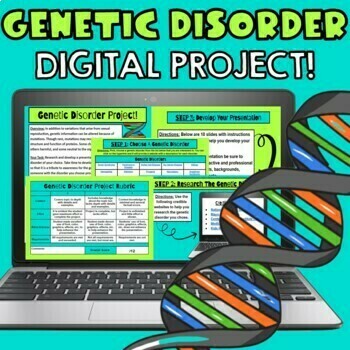Genetic Disorder Project - Research & Presentation - Google - Distance Learning!
- Google Drive™ folder
- Internet Activities

What educators are saying
Description
Genetic Disorder Project!
Step 1: Students choose a genetic disorder they are interested in researching.
Examples of genetic disorders students can choose from:
Down Syndrome, Parkinson’s Disease, Sickle Cell Disease, Tay-Sachs Disease, Vitiligo, Hemophilia, Albinism, Progeria, Narcolepsy, Angelman Syndrome, Huntington Disease, Maple Syrup Urine Disease, Osteogenesis Imperfecta, Treacher Collins Syndrome, Prader-Willi Syndrome, Xeroderma Pigmentosum, Fragile X Syndrome, Duchenne Muscular Dystrophy, Cystic Fibrosis, Color Vision Deficiency, Achondroplasia, William Syndrome, Alzheimer's Disease, Turner Syndrome, Larsen Syndrome.
Step 2: Students research the genetic disorder.
Students are given five credible websites to help them research the genetic disorder they chose.
Step 3: Students develop their presentation on the genetic disorder they chose. Students are given instructions to create 10 slides on Google Slides.
Rubric for grading presentations is included! It can be printed or used digitally!
Extension: Students can present their genetic disorders to their classmates to spread awareness of different genetic disorders. A note-taking document is included in this product. As their classmates present, students write two interesting facts they learned about the genetic disorder.
- 100% Digital! Product is created on Google Docs and Google Slides!
- NO Teacher Prep! Post directly to GOOGLE CLASSROOM!
- Editable to meet your needs.
- Great for Distance Learning!


